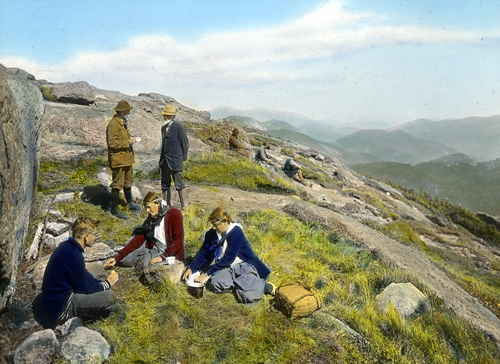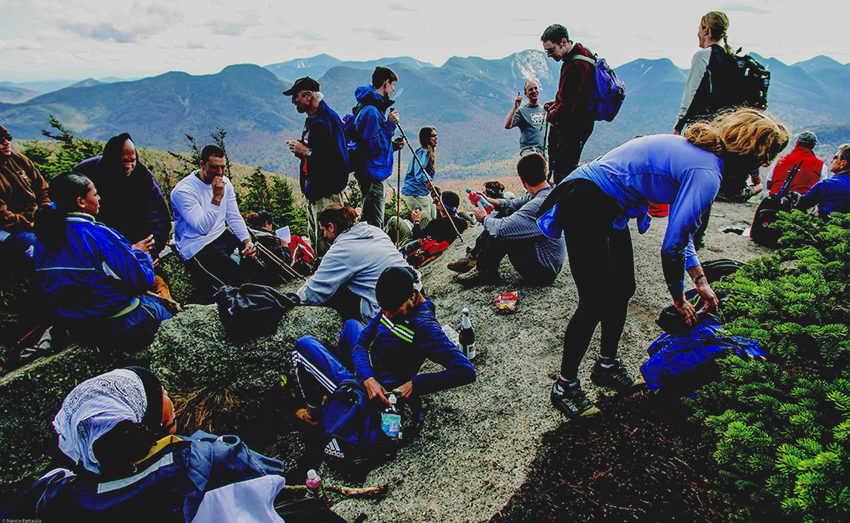
Party having lunch on top of Mount Marcy. 1919. Source: New York State Archives.
After the Civil War, Romantic ideals of pristine nature drew a growing population of urban tourists to the Adirondacks. With the desire to “search for for authentic experiences” in nature, many wealthy tourists—locally known as “sports”—came to the Adirondacks to hunt and fish in the company of hired guides such as the Abenaki guide Mitchell Sabattis. A number of local woodsmen who relied for subsistence on these activities benefitted from these lucrative opportunities, and growing tourism in the region “also gave local women an opportunity to bring their domestic stills as cooks and housekeepers into the market-place.” Sometimes the influx of urban elites confused locals, for whom sportsmen’s leisurely pastimes were their own realities. As one Adirondack hotel manager in the late 19th century remarked, “I tell you if there’s a spot on the face of the earth where millionaires go to play at housekeeping in log cabins and tents as they do here, I have yet to hear about it.” [ref] Jacoby, Crimes against Nature. [/ref]
For many of these “sports”, outdoor recreation also came to be seen as an essential way to combat a perceived decline in American masculinity. Many feared that “the masculine ruggedness displayed so heroically at Valley Forge, the Alamo, and Gettysburg had somehow been eroded by the combined forces of urbanization [and] overcivilization.” [ref] Terrie, Contested Terrain [/ref] Fears of overcivilization in America expanded in the late 19th century, and coincided with the declared “closing” of the American frontier in 1893. [ref] Turner, The Frontier in American History [/ref] The wild lands of the Adirondacks which had been defined by the Romantics as spiritual spaces also became the spaces in the late 19th century where “men from the elite and middle classes developed the muscles, self reliance, and independence” to overcome this “erosion” of masculinity, traits which were also “needed for success in the competitive world of industry and commerce.” To a lesser extent, the same logic applied to American girls “whose destiny was to be healthy wives and productive mothers.” For the children of the urban upper class, the solution to the perceived deficiencies in American youth was “the hardy life of the wilderness.” [ref] Terrie, Contested Terrain [/ref]
In the twentieth century, recreation in the Adirondacks become more accessible to people besides the privileged elite. “By the end of the nineteenth century, northern New York was known throughout the nation as a vacation mecca for both the middle class and the wealthy,” but as automobile travel made travel through the Adirondacks easier more people were able to visit and take part in low-cost recreational vacations through the twentieth century. By about 1910, many of the hiking trails in the High Peaks region had been roughly constructed by guides and climbers, such as the trail through Indian Pass constructed by Lyman Epps. The state began to build campsites and the now-quintessential lean-to shelters, which were modeled after the traditional structures that Adirondack guides had used in the backcountry. [ref] Ibid. [/ref] With new trails and increased access, hiking became especially popular.

A crowd at the summit of Big Slide. 2016. Photo by Nancie Battaglia. Source: Lynch, “Beyond Peak Capacity.”
Today, thousands of people every year come to the Adirondacks to hike, ski, paddle, and enjoy many other outdoor recreation opportunities. Recently, however, state officials have expressed concern about overuse of the Park’s most popular trails. [ref] Lynch, “Beyond Peak Capacity: A Boom In High Peaks Hikers.” [/ref] Managing wilderness areas that are as well-loved as the High Peaks can be challenging in order to ensure the safety of both visitors and the sometimes fragile ecosystems that the Forest Preserve aims to protect. Balancing different needs—for example, encouraging people of diverse backgrounds to enjoy the state’s public lands and protecting sensitive ecosystems—is the central challenge of managing the Adirondack landscape, and has been an ongoing challenge since the founding of the Park.